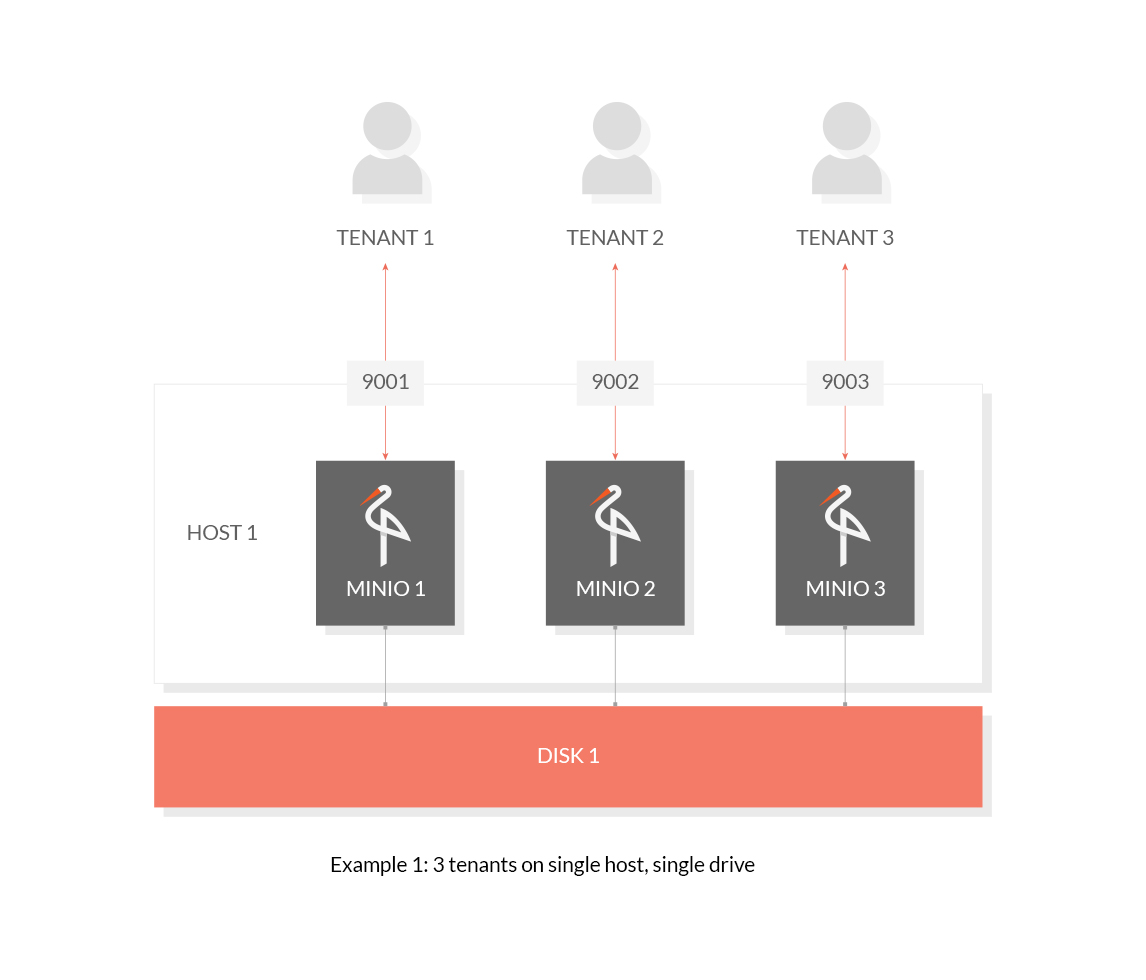- Sort Score
- Result 10 results
- Languages All
Results 1 - 10 of 35 for hosts (0.13 sec)
-
docs/distributed/CONFIG.md
arguments for the hostnames and the drives via an ellipses syntax such as `minio server http://host{1...4}/disk{1...4}` this requirement added an additional burden to have sequential hostnames for us to make sure that we can provide horizontal distribution, however we have come across situations where sometimes this is not feasible and there are no easier alternatives without modifying /etc/hosts on the host system as root user. Many times in airgapped deployments this is not allowed or requires audits...Plain Text - Registered: Sun May 05 19:28:20 GMT 2024 - Last Modified: Fri May 03 15:54:03 GMT 2024 - 4.2K bytes - Viewed (0) -
docs/multi-tenancy/README.md
### 1.1 Host Multiple Tenants on a Single Drive Use the following commands to host 3 tenants on a single drive: ```sh minio server --address :9001 /data/tenant1 minio server --address :9002 /data/tenant2 minio server --address :9003 /data/tenant3 ``` 
Plain Text - Registered: Sun May 05 19:28:20 GMT 2024 - Last Modified: Thu Sep 29 04:28:45 GMT 2022 - 3K bytes - Viewed (0) -
internal/grid/README.md
From that individual connections will be spawned to each remote server, or incoming requests will be hooked up to the appropriate connection. To get a connection to a specific server, use `Manager.Connection(host)` to get a connection to the specified host. From this connection individual requests can be made. Each handler, with optional subroutes can be registered with the manager using `Manager.RegisterXHandler(handlerID, handler, subroutes...)`.
Plain Text - Registered: Sun May 05 19:28:20 GMT 2024 - Last Modified: Thu Jan 18 07:03:17 GMT 2024 - 9.4K bytes - Viewed (0) -
docs/config/README.md
Example: ```sh
Plain Text - Registered: Sun May 05 19:28:20 GMT 2024 - Last Modified: Mon Sep 11 21:48:54 GMT 2023 - 17.7K bytes - Viewed (0) -
docs/sts/web-identity.md
MINIO_IDENTITY_OPENID_KEYCLOAK_ADMIN_URL (string) Specify Keycloak 'admin' REST API endpoint e.g. http://localhost:8080/auth/admin/ MINIO_IDENTITY_OPENID_REDIRECT_URI_DYNAMIC (on|off) Enable 'Host' header based dynamic redirect URI (default: 'off') MINIO_IDENTITY_OPENID_CLAIM_PREFIX (string) [DEPRECATED use 'claim_name'] JWT claim namespace prefix e.g. "customer1/"
Plain Text - Registered: Sun May 05 19:28:20 GMT 2024 - Last Modified: Thu Jan 18 07:03:17 GMT 2024 - 19.2K bytes - Viewed (1) -
docs/metrics/prometheus/README.md
``` Here `prometheus.yml` is the name of configuration file. You can now see MinIO metrics in Prometheus dashboard. By default Prometheus dashboard is accessible at `http://localhost:9090`.
Plain Text - Registered: Sun May 05 19:28:20 GMT 2024 - Last Modified: Fri Apr 12 15:49:30 GMT 2024 - 7.1K bytes - Viewed (0) -
docs/docker/README.md
quay.io/minio/minio server /data --console-address ":9001" ``` To create a MinIO container with persistent storage, you need to map local persistent directories from the host OS to virtual config. To do this, run the below commands ### GNU/Linux and macOS ```sh mkdir -p ~/minio/data docker run \ -p 9000:9000 \ -p 9001:9001 \ --name minio1 \ -v ~/minio/data:/data \
Plain Text - Registered: Sun May 05 19:28:20 GMT 2024 - Last Modified: Thu Sep 29 04:28:45 GMT 2022 - 8.2K bytes - Viewed (0) -
README.md
### ufw For hosts with ufw enabled (Debian based distros), you can use `ufw` command to allow traffic to specific ports. Use below command to allow access to port 9000 ```sh ufw allow 9000 ``` Below command enables all incoming traffic to ports ranging from 9000 to 9010. ```sh ufw allow 9000:9010/tcp ``` ### firewall-cmd
Plain Text - Registered: Sun May 05 19:28:20 GMT 2024 - Last Modified: Wed Feb 14 17:51:34 GMT 2024 - 18.7K bytes - Viewed (0) -
docs/distributed/DESIGN.md
``` minio server http://host{1...2}/export{1...8} ``` Expected expansion ``` > http://host1/export1 > http://host2/export1 > http://host1/export2 > http://host2/export2 > http://host1/export3 > http://host2/export3 > http://host1/export4 > http://host2/export4 > http://host1/export5 > http://host2/export5 > http://host1/export6 > http://host2/export6 > http://host1/export7Plain Text - Registered: Sun May 05 19:28:20 GMT 2024 - Last Modified: Tue Aug 15 23:04:20 GMT 2023 - 8K bytes - Viewed (0) -
docs/federation/lookup/README.md
hosts passed to the MinIO server startup and use them for DNS entries. ### Run Multiple Clusters > cluster1 ```sh export MINIO_ETCD_ENDPOINTS="http://remote-etcd1:2379,http://remote-etcd2:4001" export MINIO_DOMAIN=domain.com export MINIO_PUBLIC_IPS=44.35.2.1,44.35.2.2,44.35.2.3,44.35.2.4 minio server http://rack{1...4}.host{1...4}.domain.com/mnt/export{1...32} ``` > cluster2Plain Text - Registered: Sun May 05 19:28:20 GMT 2024 - Last Modified: Thu Sep 29 04:28:45 GMT 2022 - 4K bytes - Viewed (0)